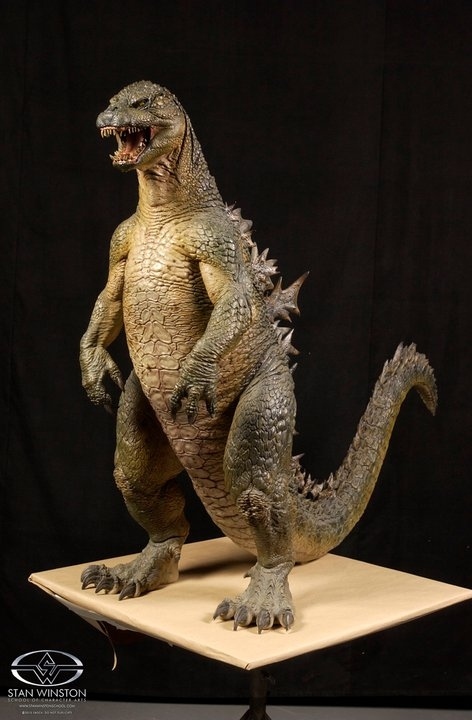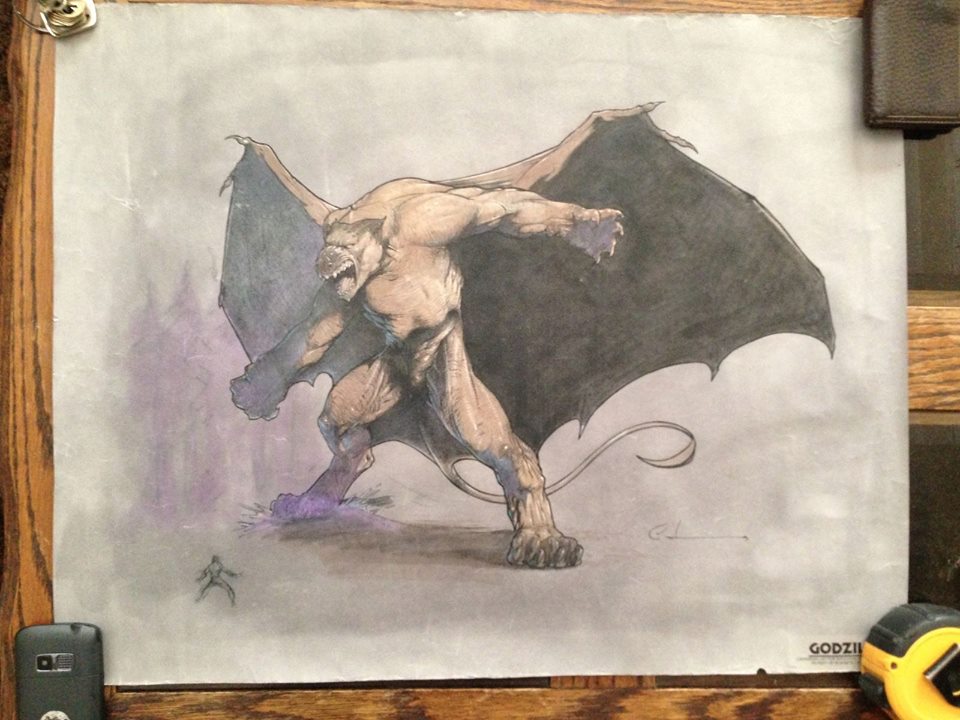Conceptual design of Godzilla by Mark "Crash" McCreery. Yes, THAT Mark "Crash" McCreery.
Sweet merciful crap, we're really getting down to the wire! We are a mere 24 days until Godzilla comes to theatres and earlier today, somebody posted a video of five minutes of footage from the new film being shown at Wondercon. I watched it and immediately saved it to my phone and probably a good thing I did too because within a few hours, Warner Bros had already taken it down from any link I could find. I won't give away too much but if there's anyone reading who didn't get a chance to see it, let's just say I had a throbbing nerd-rection and then gave me additional drive to get my ass in gear and get on these reviews.
Last time we looked at the stinker that was Roland Emmerich and Dean Devlin's Godzilla. We all have seen what was, but what about what could have been? Remember how in that review I had mentioned that Stan Winston Studios had been attached to a Godzilla film that never saw the light of day? Well, guess what one of my friends sent me the script for...
Well, all I can say is...why in the name of screaming shit didn't we get THIS one instead? This script has far more interesting characters, better dialogue and a second monster in it which leads to a final battle in New York that sounds like if it were to be made today, it'd make Pacific Rim look like nursery school. Well, like the old saying goes, "Money talks," and in the case of Godzilla, it said, "Take a hike." Director Jan De Bont had just wrapped up Speed and he got wind of this Godzilla script that had been written by Terry Rossio and Ted Elliot (the duo who helped write Aladdin and the first four Pirates Of The Caribbean films) that Tristar had. Jan loved the script and he wanted to do the movie, but he said he'd need a budget of $130 million (to put it into perspective, the budget for 1993's Jurassic Park was $63 million apprx.) to pull it off. Well, Tristar didn't have that much faith in the project to warrant such a budget so the two parted ways and the film never got off the ground...but not before Stan Winston Studios had made a couple of maquettes and concept art for the film.
Another shot of SWS's Godzilla maquette.
The plot of the unused Godzilla script is a scientist couple are called away to the Arctic where a bleeding iceberg has been discovered. Upon investigating, it turns out that it's Godzilla's tomb and the "blood" is a fluid that keeps him in a coma. Unfortunately, Godzilla wakes up and the husband is killed in the process. Flash forward a year later and the wife scientist, Jill, along with a couple of new colleagues (one who is a mythology expert who believes in the Godzilla legends) and through a bizarre turn of events, they realize that Godzilla's awakening was not coincidental and that the fate of the world rests on his shoulders, despite Jill's anxiousness to kill Godzilla and avenge her husband's death.
Okay, is the script perfect? Well, not really but we'll start with the good things about it. First off, the script is about 120 pages and if I recall correctly, a page of a script translates to about a minute of screentime (this script did take me just under two hours to read it). So were this film made, it wouldn't really be any shorter to sit through but at least it would be a two hour movie that at worst would feel like a two hour movie and at best, maybe hour and a half (unlike the one we got, which feels three hours long). Rossio and Elliot's script doesn't drag on, waste time on boring characters or stupid subplots, has plenty of action from both Godzilla and his adversary The Gryphon and overall flows really smoothly.
Okay, you're probably wondering, "Okay, so what changes did they make to Godzilla then?" Not many. As you can tell by the picture above, the overall design hasn't changed much and he does have a personality that seems like a combination of the Showa and Heisei era Godzillas (example, during the final fight, Godzilla tears the Gryphon's head off and shoves it onto one of the support pillars of the Brooklyn Bridge) but there were a couple of things used here that would find their way into the 98 film, specifically Godzilla can crouch down on all fours when needed (although he doesn't tunnel), he can run and he can jump.
Probably the most interesting thing about this script is its villain. The Gryphon simply starts out as a large alien probe that crashes into a lake and begins absorbing local wildlife and building creatures based on said wildlife's DNA, which eventually merge into one giant creature that has the body of a mountain lion, the wings of a bat and a tongue made up of many snake heads. Do keep in mind this script predates Godzilla vs Destoroyah so the whole combining to make one giant creature hadn't really been done yet (if I remember correctly). Once it has reached full form, it can still absorb traits from its prey, as it demonstrates when it swallows a shady military officer and begins using his personality tic, which I'll admit I'm torn as to whether it'd look creepy or silly onscreen. I'll give it the benefit of the doubt and go with creepy.
Conceptual design for the Gryphon.
Okay, so what was bad about it? Well, Godzilla's origins are vastly different than the original Toho film, and I do mean vastly. Okay, are you ready for this? There's one part where one of the scientists gets infected with something from Godzilla's tomb and it gradually mutates him into an alien looking being (kinda sounds like a Grey) that needed a human host to explain to the human race what they're up against. The Gryphon is from an alien race that sends probes to planets so it can take on a form based on the local biology, lay waste to any civilization and let its masters take over a per-conquered planet. The Greys are an ancient race that once inhabited Earth and they genetically engineered Godzilla based on dinosaur templates as a weapon to use against these invaders and they've created him so that the only thing that could possibly kill Godzilla is another monster. So yeah, all that nuclear weaponry allegory stuff has been tossed out the window for ALIENNNSS! This was really the only part of the script that I wasn't particularly impressed with.
Well, this review is like a day late so I should wrap this up. While Emmerich's version may have been closer to the original creature-origin wise, Rossio and Elliot's script felt like it would have kept the spirit of the Toho films and really, I think that's what fans were looking for. Isn't it odd that Tristar said no to handing over $130 million to make this Godzilla movie, but were perfectly fine for handing Devlin & Emmerich the same amount (if not more) to make the train wreck that we wound up getting? If nothing else, Todd Tennant has a web-comic in progress that follows the story of the 1994 script (mostly) so at least it didn't go entirely to waste. If you have a couple hours to spare (or less if you're a speed reader), give this script a read. I don't think you'll be disappointed.
Join us next time when we look at the Big Guy's return to form, Godzilla 2000.
-The Cynic
Well, this review is like a day late so I should wrap this up. While Emmerich's version may have been closer to the original creature-origin wise, Rossio and Elliot's script felt like it would have kept the spirit of the Toho films and really, I think that's what fans were looking for. Isn't it odd that Tristar said no to handing over $130 million to make this Godzilla movie, but were perfectly fine for handing Devlin & Emmerich the same amount (if not more) to make the train wreck that we wound up getting? If nothing else, Todd Tennant has a web-comic in progress that follows the story of the 1994 script (mostly) so at least it didn't go entirely to waste. If you have a couple hours to spare (or less if you're a speed reader), give this script a read. I don't think you'll be disappointed.
Join us next time when we look at the Big Guy's return to form, Godzilla 2000.
-The Cynic



No comments:
Post a Comment